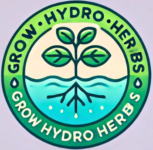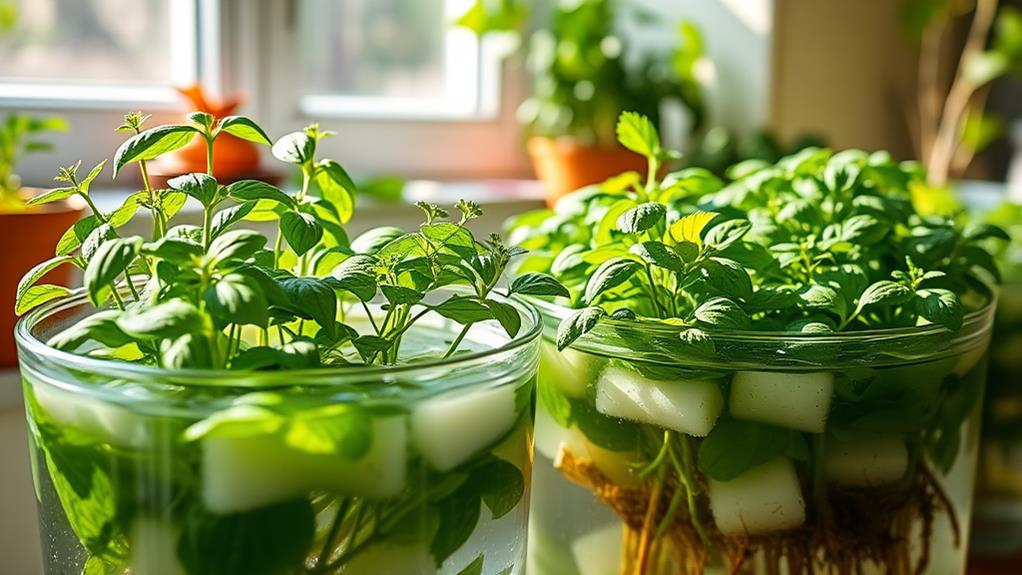Comparing Deep Water Culture vs. Kratky for Indoor Hydroponics: Which is Right for You?
Curious about indoor hydroponics but unsure which system to choose? Discover the differences between Deep Water Culture (DWC) and the Kratky Method. This guide breaks down each method’s pros and cons, helping you find the perfect fit for your gardening goals.
When you compare Deep Water Culture and Kratky Methods for indoor hydroponics, you’ll notice some key differences. Deep Water Culture (DWC) requires more equipment and maintenance, as it relies on air pumps and needs regular monitoring. It often leads to faster plant growth and larger yields. In contrast, the Kratky Method is simpler and perfect for beginners. It uses a static solution that needs minimal upkeep while promoting healthy roots. While DWC excels in nutrient control, Kratky offers a low-maintenance experience. Stick around, and you’ll uncover more insights to help you choose the right hydroponic method for your needs.
GrowHydroHerbs TLDR
- Ease of Use: Kratky is beginner-friendly, while DWC requires more maintenance and equipment.
- Growth Speed: DWC generally supports faster growth due to active oxygenation.
- Nutrient Control: DWC offers better nutrient management but demands regular monitoring.
- Maintenance: Kratky is low-maintenance with fewer technical requirements.
- Water Usage: Kratky uses less water, making it a sustainable choice.
Overview of Hydroponic Systems
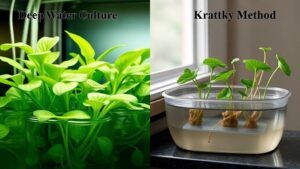
Hydroponic systems allow you to grow plants without soil, using nutrient-rich water instead.
Various methods, like Deep Water Culture and the Kratky Method, each offer unique benefits and challenges.
The Kratky Hydroponic Method is particularly appealing for beginners due to its simplicity and low maintenance requirements.
Understanding these systems can help you choose the best approach for your indoor gardening needs.
Hydroponic System Basics with the Deep Water Culture and Kratky Methods
In exploring the world of soilless gardening, you’ll find various hydroponic systems designed to grow plants efficiently without traditional soil. Two popular methods are the Deep Water Culture (DWC) system and the Kratky Method. Each has its unique features and benefits, suiting different skill levels and preferences.
| Hydroponic System | Description | Ideal For |
|---|---|---|
| DWC System | Involves actively oxygenating nutrient solutions with air pumps and stones, promoting robust growth. | Experienced growers seeking more control. |
| Kratky Method | A passive system that allows roots to access nutrients through a moist air gap. | Beginners looking for simplicity. |
| Nutrient Control | Requires regular monitoring of oxygen and nutrient levels. | Essential in both systems. |
| Setup Complexity | More complex with higher maintenance needs in DWC. | Kratky is easier to set up and maintain. |
Regardless of which hydroponic system you choose, incorporating grow lights can enhance plant growth indoors. By understanding these basics, you’ll feel more connected to your soilless gardening journey, ready to cultivate fresh produce right at home!
DWC vs. Kratky Method
Often, gardeners find themselves choosing between Deep Water Culture (DWC) and the Kratky Method for their hydroponic needs. Each system offers unique advantages, but they cater to different levels of experience and commitment.
Here’s a quick comparison to help you decide:
- Complexity: DWC requires an air pump and air stones for oxygenation, making it more complex. The Kratky Method is simpler, relying on a passive setup.
- Maintenance: DWC needs regular checks on water levels and nutrient concentration to avoid issues like root rot. Kratky is low-maintenance, perfect for beginners who want a straightforward experience.
- Plant Variety: Both systems can grow leafy greens effectively, but DWC offers greater control over nutrient levels, appealing to more experienced growers.
- Setup Time: DWC takes longer to set up due to equipment requirements. In contrast, the Kratky Method can be up and running quickly, allowing you to start your gardening journey sooner.
In the end, your choice between DWC and the Kratky Method will depend on your comfort level and how hands-on you want to be.
Both systems can lead to thriving plants, so you can’t go wrong!
Benefits of Hydroponics
For anyone looking to grow plants efficiently, hydroponics offers a range of benefits that make it an appealing choice. Whether you’re a seasoned gardener or just starting out, systems like Deep Water Culture (DWC) and the Kratky Method can enhance your indoor gardening experience.
DWC allows you to maintain better control over nutrient delivery, perfect for those who enjoy a hands-on approach. You’ll find that the active oxygenation promotes faster growth, especially in leafy greens. Additionally, proper hydroponic lighting is essential for maximizing plant health and yield, which can further enhance the advantages of these systems.
However, if you’re new to hydroponics, the Kratky Method offers a simpler, passive alternative that’s incredibly user-friendly. It requires minimal setup and provides efficient water usage, making it accessible for everyone.
Both methods can effectively support plants, but the choice ultimately depends on your experience and preferences. While DWC might require more attention and resources, the Kratky Method allows you to enjoy gardening with less fuss.
Regardless of which system you choose, hydroponics fosters a sense of community among growers, as you can share tips, successes, and even your harvests. Embracing hydroponics connects you with other enthusiasts, making your indoor gardening journey rewarding and fulfilling.
Deep Water Culture Explained
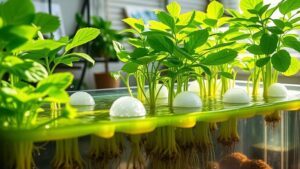
In Deep Water Culture, you submerge plant roots in a nutrient-rich solution, ensuring they get all the nutrients they need.
By using air pumps and stones, you actively oxygenate the water, which is essential for healthy growth.
This system allows you to have more control over nutrient levels and oxygen supply, making it perfect for growers who want faster results.
System Overview
Deep Water Culture (DWC) is a hydroponic system that revolves around the concept of keeping plant roots submerged in a nutrient-rich solution while simultaneously providing ample oxygen. This method is ideal for those who want to see rapid growth in their plants, especially leafy greens. However, it requires careful management to thrive.
Here are four important components of DWC to keep in mind:
- Oxygenation: An air pump and air stones are essential for delivering oxygen to the nutrient solution.
- Monitoring: Keeping the pH level between 5.5 and 6.5 and maintaining an electrical conductivity (EC) of around 1.2 is crucial for best growth.
- Airflow: Proper airflow helps remove heat and humidity, enhancing transpiration rates and preventing nutrient deficiencies.
- Maintenance: This system demands more attention than simpler methods, making it best suited for experienced growers.
While DWC can lead to impressive growth rates, it also poses challenges, such as high water consumption and potential plant stress if oxygen levels drop.
Oxygenation Techniques
Maintaining ideal oxygen levels in a Deep Water Culture (DWC) system is vital for healthy plant growth. To achieve this, you’ll rely on an air pump and air stones that efficiently aerate your nutrient solution. This setup not only promotes robust root development but also enhances nutrient uptake, creating a thriving environment for your plants.
It’s important to regularly monitor the oxygenation to prevent plant stress and potential root rot, as stagnant water can lead to anaerobic conditions. You want to avoid the heartbreak of early plant death, so make sure your oxygen levels remain consistent.
While DWC offers more control over nutrient levels and oxygen supply, it does involve complexities that require a bit more expertise. Don’t let this intimidate you!
With a higher volume of water comes the responsibility of maintaining excellent conditions, but you’ll find the rewards are worth the effort. Embrace the challenge, and join a community of growers who understand the nuances of DWC.
Together, you can share tips and experiences, creating a sense of belonging among fellow hydroponic enthusiasts.
The Kratky Method Explained
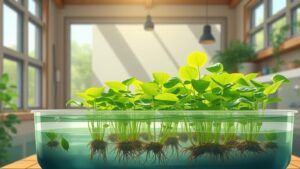
The Kratky Method is a straightforward hydroponic system that allows you to grow plants without the need for pumps or complicated setups.
By using a nutrient tub and maintaining a moist air gap, this method offers several advantages, especially for beginners.
However, it also comes with its own set of limitations that you’ll want to take into account.
System Overview
A simple and effective way to grow plants hydroponically is through the Kratky Method, which relies on a passive system that doesn’t need additional oxygenation. This makes it a perfect choice for those new to hydroponics or anyone looking for an easy setup.
Here’s a quick overview of the Kratky Method:
- Nutrient Tub: You’ll use a container filled with nutrient solution, covered with a lid to prevent evaporation and algae growth.
- Moist Air Gap: As the plants grow, their roots reach down to access the nutrients while a moist air gap promotes healthy root development.
- Water Usage: Each plant typically needs about 3-6 liters of water throughout its lifetime, utilizing capillary action for nutrient movement.
- Cost-Effective Materials: You can build your system using affordable materials, like foam board for the lid, making it accessible for everyone.
With its straightforward design, the Kratky Method encourages a sense of community among indoor gardeners, allowing you to grow delicious lettuce and other greens with confidence.
You’ll find that this simple approach makes hydroponics not just possible, but enjoyable!
Advantages and Disadvantages
Utilizing the Kratky Method offers several advantages, particularly for beginner hydroponic gardeners. This passive system is incredibly simple to set up, requiring minimal technical knowledge and fewer components than the Deep Water Culture (DWC) method.
You won’t need to worry about air pumps or stones, which can be intimidating for newcomers. Instead, your plants will thrive in a nutrient solution that allows for a moist air gap, promoting healthy root growth. Additionally, the Kratky Method is suitable for a variety of herbs, including hydroponic-friendly herbs like basil and mint, enhancing your gardening experience.
One of the standout benefits of the Kratky Method is its low maintenance. With no active oxygenation needed, you can focus on nurturing your plants rather than constantly managing equipment. It’s particularly effective for growing leafy greens like lettuce, making it a great choice for those looking to start with easy-to-manage crops.
However, there are some disadvantages. The Kratky Method limits your control over nutrient levels and oxygen supply, which could affect growth if not monitored closely.
While it’s perfect for beginners, as you gain experience, you might find DWC offers more versatility for a wider variety of plants. Ultimately, it’s about finding the method that fits your gardening style and goals.
Comparing Maintenance Requirements

When comparing maintenance requirements, you’ll notice significant differences between Deep Water Culture (DWC) and the Kratky Method.
DWC demands regular attention to equipment like air pumps and constant monitoring of water and nutrient levels, while the Kratky Method keeps things simple with minimal upkeep after setup.
Understanding these differences can help you choose the right system for your gardening needs.
System Complexity Differences
Many growers find that the complexity of hydroponic systems can greatly affect their maintenance requirements.
When choosing between Deep Water Culture (DWC) and the Kratky Method, it’s important to weigh how much time and effort you want to invest.
Here’s a quick comparison of maintenance needs:
- DWC Complexity: Requires air pumps and stones to oxygenate the nutrient solution, which can be challenging for beginners.
- Regular Monitoring: You’ll need to frequently check oxygen levels and nutrient concentrations in DWC to keep your plants thriving.
- Adjustments: DWC demands adjustments in air stone size and placement, adding to the complexity.
- Kratky Simplicity: The Kratky Method, being passive, doesn’t require pumps, making it easier to set up and maintain.
For those just starting, the Kratky Method offers a straightforward approach, allowing you to enjoy the growing experience without the added stress.
Meanwhile, if you’re up for a challenge and want more control over your plants, DWC might be your go-to.
Ultimately, knowing your comfort level with complexity will guide you to the right choice for your indoor garden.
Water Management Practices
Balancing water management is essential when comparing maintenance requirements between Deep Water Culture (DWC) and the Kratky Method.
If you’re looking for a system that requires less attention, the Kratky Method is a fantastic option, especially for beginners. Since it relies on passive aeration, you won’t need to constantly monitor oxygen levels or run air pumps. Instead, you can enjoy a more relaxed approach to gardening.
On the other hand, DWC demands regular checks on water levels and nutrient concentrations to keep your plants healthy. This can be a bit overwhelming if you’re new to hydroponics. The continuous circulation of water in DWC can lead to higher water consumption, so be prepared for that.
Without diligent monitoring, you risk rapid water depletion and potential plant failure.
In contrast, the Kratky Method’s static nutrient solution and moist air gap make it more forgiving when it comes to fluctuations in water levels.
Equipment and Supplies Needed
Understanding the equipment and supplies needed for each hydroponic method can help you make an informed choice based on your maintenance preferences.
If you’re looking for a system that aligns with a more hands-off approach, the Kratky Method is likely your best bet. It’s simple, requiring just a few items:
- Nutrient tub
- Lid to prevent algae
- Growing medium (if desired)
- Seeds or seedlings
On the other hand, if you’re up for a bit more work, Deep Water Culture (DWC) offers robust growth but at a cost. The equipment list is more extensive:
- Air pump for oxygenation
- Air stones for distributing air
- Nutrient solution
- Water reservoir
DWC demands regular monitoring of water levels and nutrient concentrations, which can be a challenge for beginners.
Plus, the operational costs can add up due to electricity usage. In contrast, the Kratky Method’s passive nature means less oversight and lower maintenance expenses.
Plant Growth Outcomes
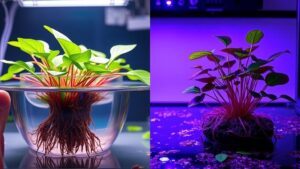
When you compare the growth outcomes of Deep Water Culture and the Kratky Method, you’ll notice distinct differences in growth rates and nutrient uptake efficiency.
While DWC often leads to larger plants, the Kratky Method can maintain healthier roots with less water.
Evaluating plant health in both systems reveals valuable insights into which method might be best for your needs.
Growth Rate Comparison
Comparing growth rates between Deep Water Culture (DWC) and the Kratky method reveals significant differences influenced by their operational complexities.
If you’re considering these methods, here’s what you should know about their growth outcomes:
- Rapid Growth vs. Consistency: DWC can lead to fast growth for experienced growers, but it also faces rapid water usage issues that can jeopardize plants.
- Simplicity for Beginners: The Kratky method is simpler and often results in more consistent growth rates, making it ideal for those just starting out.
- Nutrient Uptake: With its passive design, Kratky promotes effective root growth through a moist air gap, which can enhance nutrient uptake, especially for leafy greens like lettuce.
- Fruit Yield Differences: While DWC supports larger plants and can yield more fruit, it may experience delays in flowering compared to the Kratky method, which still achieves impressive yields.
Nutrient Uptake Efficiency
While both Deep Water Culture (DWC) and the Kratky Method can support plant growth, their nutrient uptake efficiency varies considerably.
DWC systems excel in enhancing nutrient absorption thanks to their active oxygenation through air pumps and stones. This means that when conditions are just right, your plants can grow faster and larger. However, it does require regular maintenance and some know-how to get it right.
On the flip side, the Kratky Method is a simpler, passive approach. It allows plants to soak up nutrients through a moist air gap, making it perfect for beginners. While this method is easier to manage, it doesn’t provide the same level of nutrient uptake efficiency, which could result in slower growth.
Plus, the static nutrient reservoir helps conserve water, making it a more sustainable choice.
Both systems require you to keep an eye on pH levels between 5.5 and 6.5. With DWC, you might consume more water due to aeration, but if you’re looking for fast results, it’s hard to beat.
Choose the method that feels right for you, and enjoy the journey of indoor gardening!
Plant Health Assessment
Evaluating plant health in hydroponic systems reveals significant differences in growth outcomes between Deep Water Culture (DWC) and the Kratky Method. Each method has its strengths and weaknesses, impacting your gardening experience.
Here’s what you should keep in mind:
- Water Usage: DWC has the highest water consumption, making it less sustainable long-term compared to Kratky.
- Plant Size and Yield: While DWC produces larger plants, Kratky excels in fruit yield without needing active aeration.
- Flowering Rates: DWC plants, especially tomatoes, may flower slower, which could affect your overall harvest.
- Root Health: The Kratky Method fosters healthier root systems through consistent nutrient access, minimizing plant stress.
If you’re looking for a simpler, more efficient way to grow, the Kratky Method may resonate with you. It’s user-friendly and perfect for those who want to enjoy gardening without the complexity of maintaining a DWC system.
Ultimately, your choice will depend on your gardening goals, experience level, and commitment to upkeep. Both methods can lead to fruitful outcomes, but understanding their differences can help you thrive in your hydroponic journey.
Choosing the Right Method
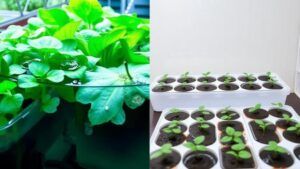
When choosing between Deep Water Culture and the Kratky Method, consider your skill level and how much maintenance you’re willing to commit to.
Each method has distinct setup needs and can fit different spaces, so think about what works best for your environment.
Skill Level Requirements
Choosing the right hydroponic method often hinges on your skill level and experience. If you’re just starting out, you might want to contemplate the Kratky Method. It’s simple and doesn’t require fancy equipment.
However, if you’re more experienced and looking for greater control, Deep Water Culture (DWC) could be your go-to.
Here’s a quick comparison to help you decide:
- Skill Level: DWC needs more expertise due to oxygen management, while Kratky is beginner-friendly.
- Setup Complexity: DWC involves pumps and air stones, adding complexity; Kratky is straightforward with minimal setup.
- Nutrient Control: DWC allows precise nutrient adjustments, but this means more responsibility; Kratky relies on capillary action for ease.
- Maintenance: DWC requires regular monitoring and intervention; Kratky mostly takes care of itself.
Your choice should reflect where you’re at in your gardening journey.
Don’t be intimidated—many growers have found joy and success in both methods, so pick the one that feels right for you.
Maintenance and Upkeep
Maintaining your hydroponic system effectively can greatly impact your plant growth, so it’s vital to understand the upkeep requirements of each method.
If you choose Deep Water Culture (DWC), be prepared for a bit more hands-on involvement. You’ll need to regularly check and maintain the air pumps and stones to guarantee your plants get enough oxygen. Monitoring water levels and nutrient concentrations is also fundamental to prevent deficiencies and maintain ideal pH levels.
Additionally, keep a close eye on water temperature to avoid stress and root rot.
On the other hand, the Kratky Method is a simpler, more passive approach. Its minimal upkeep makes it perfect if you’re just starting out. You won’t have to fuss over pumps or complicated setups; just monitor your water levels occasionally.
The natural evaporation helps maintain the moisture needed for your plants without the need for active aeration.
Ultimately, your choice depends on how much time and effort you want to invest. Whether you opt for DWC or Kratky, understanding their maintenance needs guarantees a thriving indoor garden that you’ll love nurturing.
Space and Setup Needs
Understanding the space and setup needs of each hydroponic method can make a significant difference in your gardening experience.
When choosing between Deep Water Culture (DWC) and the Kratky Method, consider the following factors:
- Container Size: DWC systems typically require larger containers, like 30-liter squat tubs, while Kratky setups are more flexible and can fit into smaller spaces.
- Equipment Needs: DWC relies on air pumps and stones for oxygenation, which makes it more complex. The Kratky Method, however, is passive and requires no additional equipment.
- Maintenance: DWC demands active management of water levels and nutrient adjustments. In contrast, the Kratky Method is easier to maintain, with less frequent intervention needed.
- Space Efficiency: If you’re working with limited indoor space, the Kratky Method is often more suitable due to its simpler design and lower reliance on mechanical components.
DWC or Kratky Method: Making the Best Choice for Your Indoor Hydroponic Garden
To sum up, choosing between Deep Water Culture and the Kratky Method boils down to your gardening style and goals. If you want rapid growth and don’t mind some maintenance, DWC is your go-to. But if you prefer a hassle-free approach, the Kratky Method is perfect for you. For instance, a beginner could easily start with Kratky and enjoy a bountiful basil harvest while gaining confidence before diving into the complexities of DWC. Happy gardening!
Questions? We Have Answers.
Get answers to a list of the most Frequently Asked Questions.
